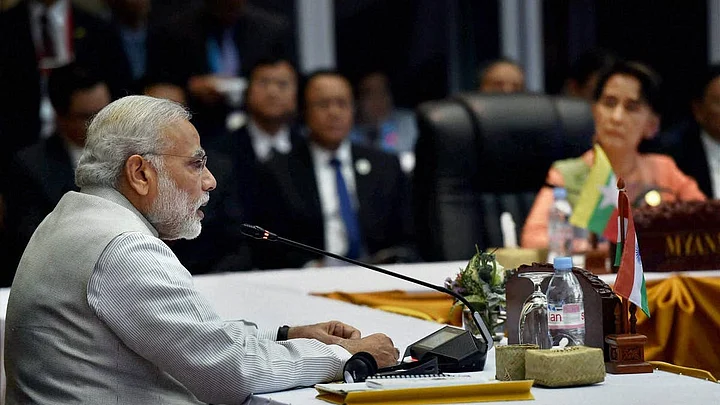It was planned as a seamless connect between India and its Southeast Asian neighbours, a motorable highway through the northeast to Myanmar and beyond to Thailand, that would see an exchange of goods, people, and the intermingling of cultures. But the Trilateral Highway, one of India's main connectivity projects with the Asean, is sadly nowhere near completion, even as Prime Minister Narendra Modi leaves to attend the 15th India-Asean Summit in Manila on Sunday.
The 1,700-km Trilateral Highway, connecting India, Myanmar and Thailand, was to have been completed by 2016, according to a Joint Task Force meeting between the three countries in September 2012. But the target has been slipping continuously, and has now been pushed back, with 2020 being given as a tentative date.
What is “The Highway of Opportunity” Waiting for?
Modi had, in his speech at the 13th Asean-India Summit in Kuala Lumpur in November 2015, assured that "the Trilateral Highway project is making good progress and should be completed by 2018". His government has maintained that its Act East Policy is more robust and execution-oriented than the previous regime's Look East Policy.
The delay in completion comes even as China pushes vigorously forward with its own connectivity corridors with neighbours, as well as setting up collateral infrastructure like warehouses, factory sheds and office blocks.
The year 2017 is special in Asean-India ties, with both sides commemorating the silver anniversary of their dialogue partnership, and the 10-member grouping is also celebrating its golden jubilee. The Modi government has in celebration of the ties invited all the heads of the 10-member Asean nations for the Republic Day Parade in January.
The Trilateral Highway project – to link Moreh in Manipur, India, to Mae Sot in Thailand through Mandalay in Myanmar – was in fact inked by the previous NDA government under AB Vajpayee. It was visualised as a "highway of opportunity and friendship that would facilitate not just the movement of goods and services, but also of people and ideas".
The Strengths and Links
Rajiv Bhatia, who was India's Ambassador to Myanmar when the project was launched in 2002, told IANS: "The deadline keeps getting pushed into the future... The Indian government is doing what it can. The final issue is connectivity to Asean."
According to Prabir De, coordinator of the Asean-India Centre at the Research and Information System for Developing Countries (RIS), the Border Roads Organisation (BRO) has upgraded the 160-km Tamu-Kalewa-Kalemyo section of the highway in Myanmar at a cost of $27.28 million. And development of a new road between Kalewa to Yargi (around 120 km) in Myanmar is ongoing.
The highway also involves strengthening or rebuilding of 69 bailey bridges of World War II vintage, which will allow it to take container loads, besides passenger movement.
De says that the earlier military junta in Myanmar had not shown much interest in the project, but State Counsellor Aung San Suu Kyi is "very positive" about it and "Prime Minister Modi has taken a personal interest in its completion".
The three countries are also negotiating a Motor Vehicle Agreement to allow vehicles to travel without a hitch on the highway.
"The negotiations have not started so far, probably Myanmar takes the line that they will do it closer to the time when the highway is ready," said Bhatia.
After it is completed, the highway is to be linked to Cambodia, Lao PDR and Vietnam. It could then serve as a lifeline between India's northeast and the Mekong region.
India inked an MoU with Myanmar on cooperation in upgrading the 69 bridges during the visit of President U Htin Kyaw in August 2016. Another MoU was inked for upgradation of the Kalewa-Yargi road section of the highway.
An Issue of India’s Relations With Neighbours
Sonu Trivedi, Professor of International Relations at Delhi University who specialises in Southeast Asia and connectivity issues, told IANS that the delay in completing the project is an issue in India's relations with its Southeast Asian neighbours, especially Myanmar and Thailand.
The countries are eagerly awaiting how and when it will be implemented, and the delay is causing certain anxiety in their minds, particularly in the changed environment in the region, especially after the speech given by President Xi Jinping (on the Belt and Road initiative) and his elevation. That is why they are now looking towards India, as a country which is significantly going to play the balancing power in the region, and that is why this delay is causing an issue between the countries that are falling in this route.
Congress MP Shashi Tharoor, who is also Chairman of the Parliamentary Standing Committee on External Affairs, told IANS: "Both Look East and Act East have rightly identified essential needs, both to open up to our Southeast Asian neighbours and to boost connectivity with, and economic growth in, our own northeastern states. Unfortunately, getting roads built and rail lines installed is far more difficult than making speeches. Project execution is our besetting weakness and the comparison with China is stark."
(Published in an arrangement with IANS.)
(Breathe In, Breathe Out: Are you finding it tough to breathe polluted air? Join hands with FIT in partnership with #MyRightToBreathe to find a solution to pollution. Send in your suggestions to fit@thequint.com or WhatsApp @ +919999008335)
(At The Quint, we question everything. Play an active role in shaping our journalism by becoming a member today.)
